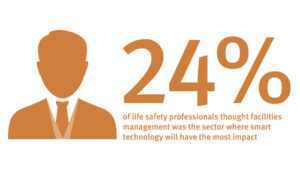 According to new research published by Hochiki Europe, 39 per cent of respondents believe the industry is not equipped to adapt to the technological demands of the smarter city movement.
According to new research published by Hochiki Europe, 39 per cent of respondents believe the industry is not equipped to adapt to the technological demands of the smarter city movement.
The research forms part of the report, Smart Cities: Building Life Safety into the Urban Landscape, which examines the views of hundreds of installers across EMEA and India to determine the future of the urban environment and the place of life safety technology within it.
Despite concerns about the readiness of the life safety industry to adapt to smart city ways of working, almost half (48 per cent) of installers said they were, however, confident that the life safety industry would still be able to keep people safe in future smart cities. Some respondents went further, with nearly a fifth (18 per cent) stating people would be even safer in smart cities than they are in current ‘non-smart’ towns.
Simon May, Technical Manager at Hochiki Europe explained: “With smart cities now a focus for many global planning authorities given their potential to improve the sustainability and liveability of the built environment, urban planners are only now scratching the surface of how advanced communications infrastructure can help enhance life safety provision to city residents.”
Looking to the future of city planning, almost a quarter (24 per cent) of respondents thought demand for the smart approach would come directly from consumers who want to live in environments that are connected, efficient and sustainable. The most important aspect of a smart city, according to nearly a third (31 per cent) of installers, was a metropolitan area planned with residents’ health and wellbeing in mind. This was followed by over a quarter (26 per cent) who stated their focus was on greater communications connectivity, and almost a fifth (17 per cent) who thought sustainability would be top of their agenda.
 Given the value of the Internet of Things (IoT) in creating and building an advanced cityscape, it is little surprise that, when asked to list the sectors most affected by smart technology, one in four (24 per cent) installers thought Facilities Management would feel the greatest impact. Equally, with cloud based monitoring systems at their heart, the life safety sector came in second with 18 per cent, followed by the healthcare sector at 12 per cent, education at 11 per cent and construction at 10 per cent.
Given the value of the Internet of Things (IoT) in creating and building an advanced cityscape, it is little surprise that, when asked to list the sectors most affected by smart technology, one in four (24 per cent) installers thought Facilities Management would feel the greatest impact. Equally, with cloud based monitoring systems at their heart, the life safety sector came in second with 18 per cent, followed by the healthcare sector at 12 per cent, education at 11 per cent and construction at 10 per cent.
Simon May continued: “Examining the value of smart technology in city planning provides a breadth of information to help explore the impact of smart cities on life safety, both in terms of the possibilities they offer and the challenges that will need to be addressed to ensure we succeed in further improving fire safety in the built environment. In doing this, we can make sure every area of the sector is equipped to face the future, laying the foundations to deliver an even safer urban landscape that everyone can enjoy.”
To download Hochiki Europe’s report, Smart Cities: Building Life Safety into the Urban Landscape, visit here


